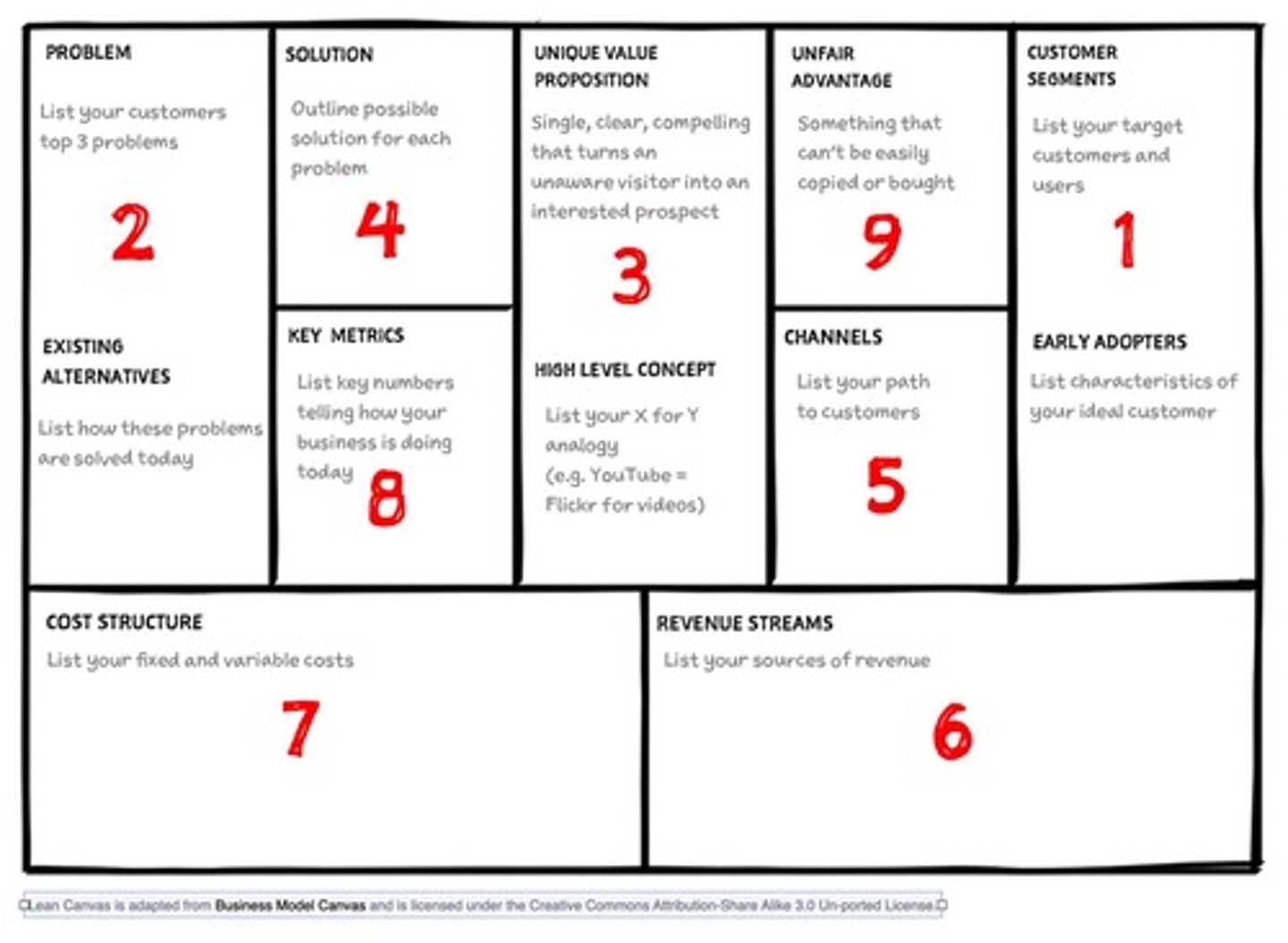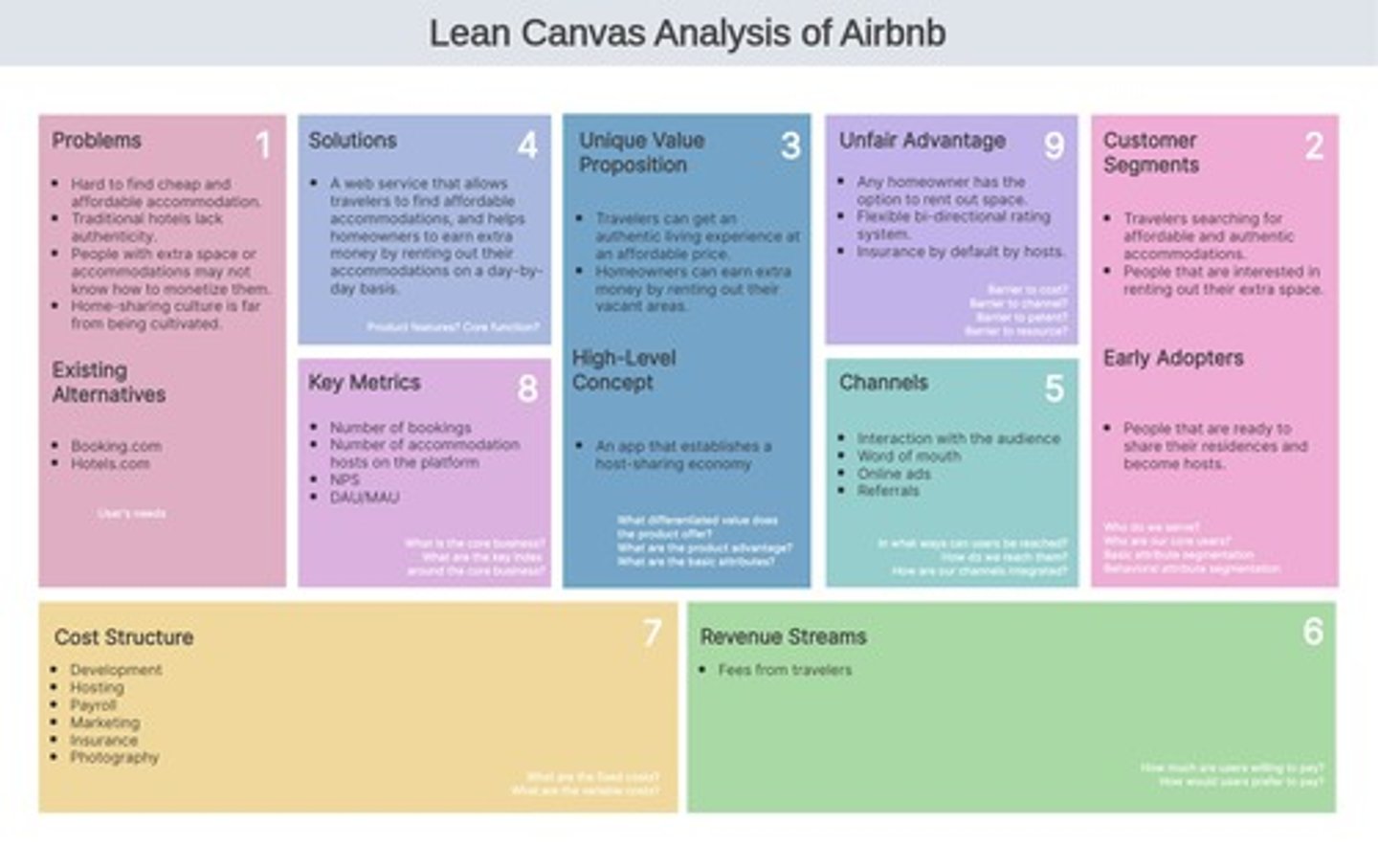People Management and Lean Canvas for Startups
1/99
There's no tags or description
Looks like no tags are added yet.
Name | Mastery | Learn | Test | Matching | Spaced |
|---|
No study sessions yet.
100 Terms
Hiring Importance
Shaping startup's future through strategic employee selection.
Employee Role
Each team member significantly influences startup success.
Strategic Hiring
Ensures operational efficiency and fosters innovation.
Brand Recognition Challenge
Limited visibility makes attracting talent difficult.
Budget Constraints
Limits salary offers and employee benefits.
Multi-skilled Employees
Startups require adaptable team players with diverse skills.
Hiring Timing
Start hiring with clear workload overflow or skill gaps.
Purposeful Hiring
Avoid rushing; hire with intention and timing.
Over-hiring Risks
Can drain cash flow in early stages.
Clear Job Descriptions
Draft descriptions outlining tasks and goals clearly.
Aligning Roles
Job roles should match company priorities and growth.
Candidate Transparency
Be honest about startup conditions and opportunities.
Job Boards
Post openings on platforms like Kalibrr and LinkedIn.
Referrals for Candidates
Utilize mentors and industry contacts for recommendations.
Networking Events
Attend events like hackathons to find talent.
Culture Fit
Assess if candidates thrive in fast-paced environments.
Evaluating Potential
Prioritize attitude and adaptability over experience.
Structured Interviews
Ensure fair comparison of candidates during interviews.
Situational Questions
Ask relevant questions to assess problem-solving skills.
Confidentiality Agreements
Protect startup with confidentiality and IP agreements.
Probationary Periods
Evaluate fit within initial 6 months of employment.
Onboarding Process
Introduce mission, vision, and team to new hires.
Startup Culture
Foster values of openness, learning, and teamwork.
Retention Strategies
Offer growth paths and regular mental wellness check-ins.
Hiring Mistakes
Avoid urgency-driven decisions and skipping reference checks.
Growth-Oriented Hiring
Select team members who can evolve with the business.
Labor Rights
Legal protections ensuring fair working conditions.
Labor Code
Philippine law governing labor rights and regulations.
Employee Protection
Safeguards against abuse and exploitation in workplaces.
Security of Tenure
Job stability; dismissal requires just cause.
Due Process
Legal procedure must be followed for termination.
Fair Compensation
Entitlement to minimum wage and timely payment.
Overtime Pay
Additional pay for hours beyond standard workday.
Leave Benefits
Includes various types of leave for employees.
13th Month Pay
Mandatory bonus calculated as 1/12 of salary.
Equal Opportunity
No discrimination; equal pay for equal work.
Right to Organize
Workers can form unions and engage in bargaining.
Employer Responsibilities
Obligations to provide fair contracts and safety.
Standard Working Hours
Typically 8 hours per day for employees.
Workplace Safety
Compliance with OSH Law for health and safety.
Labor Dispute Resolution
Grievances handled by DOLE or NLRC.
Mediation
Preferred method for resolving labor disputes.
Penalties for Violations
Fines or closure for breaching labor laws.
Public Image Impact
Labor violations can harm company reputation.
Service Incentive Leave
5 days of leave granted annually to employees.
PPE
Personal protective equipment required for workplace safety.
Government-Mandated Benefits
Includes SSS, PhilHealth, and Pag-IBIG contributions.
Diversity in Workplace
Encouraged to promote inclusivity and equal treatment.
Lean Thinking
Approach to eliminate waste and maximize value.
Minimum Viable Product (MVP)
Early version to test business assumptions quickly.
Lean Canvas
One-page model identifying key business assumptions.

Ash Maurya
Creator of the Lean Canvas for startups.
Traditional Business Plans
Long, rigid plans often outdated upon implementation.
Business Model Canvas (BMC)
Visual framework for established companies' business models.
Customer Segments
Target users and buyers for your product.
Unique Value Proposition (UVP)
Distinct value offered to customers compared to competitors.
Channels
Methods to reach and deliver value to customers.
Revenue Streams
Ways a business generates income from customers.
Key Metrics
Critical indicators to measure business performance.
Unfair Advantage
Unique edge over competitors that is hard to replicate.
Problem
Top issues faced by customers needing solutions.
Solution
Core features addressing customer problems effectively.
Persona
Detailed representation of target customer archetypes.
Iterate
Refine product based on user feedback and testing.
Validation
Process of confirming assumptions through customer feedback.
High Level Concept
Analogy comparing your product to known brands.
Ground Rules
Guidelines for effective use of the Lean Canvas.
Early Adopters
Initial customers who embrace new products quickly.
Behavior Observation
Method to understand customer actions and preferences.
Frustration Interviews
Conversations to uncover customer pain points.
Classroom Projects
Use of Lean Canvas for educational purposes.
Revenue Streams
Ways a business generates income.
Transaction Fees
Charges applied per transaction processed.
Subscription Models
Recurring payments for ongoing services.
Licensing
Permission to use intellectual property for a fee.
Customer Acquisition Cost (CAC)
Cost incurred to acquire a new customer.
Lifetime Value (LTV)
Total revenue expected from a customer relationship.
Retention Rate
Percentage of customers who continue using a service.
Churn Rate
Percentage of customers who stop using a service.
Burn Rate
Capital spent before achieving profitability.
Monthly Recurring Revenue (MRR)
Predictable monthly income from subscriptions.
Gross Profit Margin
Revenue remaining after deducting cost of goods sold.
Conversion Rate
Percentage of visitors taking a desired action.
Average Revenue per User (ARPU)
Average revenue generated per customer.
Net Promoter Score (NPS)
Measures customer satisfaction and loyalty.
Sales Growth
Rate of increase or decrease in sales revenue.
Unfair Advantage
Unique assets that competitors cannot replicate.
Brand
Distinctive identity that differentiates a business.
Proprietary Technology
Unique tech developed exclusively for a business.
Customer Segments
Different groups targeted by a business.
Unique Value Proposition (UVP)
Distinct benefits offered to customers.
High Level Concept
Simple analogy explaining a business model.
Existing Alternatives
Current options available to consumers in the market.
Platform
Online marketplace connecting travelers with hosts.

Mobile App
Allows users to search and book properties.
Trust and Safety
Includes reviews, verification, and secure payments.
Online Platform
Airbnb's website and mobile applications.
Digital Marketing
Promotional strategies using social media and SEO.
Referral Program
Rewards for users referring new travelers or hosts.
Public Relations
Media partnerships and influencer collaborations.